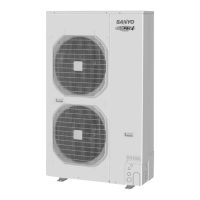4-6
4
Heating Mask Time
This refers to the shortest time that heating operations must be performed without defrosting operations being executed.
The mask time for this model is 25 minutes.
Ending defrosting conditions
Defrosting operations will not be commenced until the defrosting mask time has elapsed, even if frost adherence has
been detected.
*
Ending Defrosting
Defrosting operations are ended when the following conditions are aligned.
When the temperature of the outdoor heat exchanger temperature sensor (C1) is 12 or higher.(a)
When the temperature of the outdoor heat exchanger temperature sensor (C1) is 7 or higher for 60 consecutive
seconds.
(b)
The appropriate rotations per minute for the outdoor unit fan are determined in accordance with the outdoor
air temperature and the frequency of the compressor inverter.
The outdoor unit fan step is controlled between a range of W1 (Step 1) and WD (Step 14).
When defrosting has been initiated for 10 minutes.(c)
9) Outdoor Unit Fan Control
(1) Cooling Mode
The appropriate rotations per minute for the outdoor unit fan are determined in accordance with the outdoor
air temperature and the frequency of the compressor inverter.
The outdoor unit fan step is controlled between a range of W1 (Step 1) and WE (Step 15).
* However, the outdoor unit fan is halted (Step 0) when defrosting is being carried out.
(2) Heating Mode
10) Outdoor Unit's Electrical Expansion Valve Control
The electrical expansion valve controls the amount of refrigerant that is allowed to flow in accordance with the
operation status.
The valve is adjusted in accordance with the discharge temperature (TD), the outdoor heat exchanger
temperature sensor (C1), the suction temperature sensor (TS), and the indoor unit's heat exchanger
temperature sensors (E1 and E2.)
Controlled so that the section temperature (TS) - indoor heat exchange temperature minimum (E1 and E2)
is between 1 and 5 under normal conditions.
There are cases where the aperture opens wider than usual if the discharge temperature increases.
(1) Cooling Mode
Controlled so that the section temperature (TS) - outdoor heat exchange temperature (C1) is between 1
and 5 under normal conditions.
There are cases where the aperture opens wider than usual if the discharge temperature increases.
(2) Heating Mode
11) Solenoid valve Control
The solenoid valve is switched on when normal operations have been halted and before and after
defrosting operations in order to stabilize differences between refrigerant pressure (reduced pressure).
There are also cases in which it is switched on at the start of operations when the outdoor air temperature
is low in order to stabilize the behavior of the oil.
It is basically kept off, but there are cases when it is switched on for brief periods at the start of operations
when the outdoor air temperature is low.
(1) Normal Operations Mode
It is switched on for approximately 1 minute before and after defrosting operations.
(2) Defrosting (Heating) Operations
Switched on for a maximum of 30 minutes in order to stabilize pressure before and after compressor
operations.
(3) When Operations are Halted
SM830161Book.indb6SM830161Book.indb6 2008/06/069:52:482008/06/069:52:48

